Table of contents
- Portrait of the brough specialist Kurt Harries At the same height
- “Kurt, now pick that thing up.”
- Only the finest
- 308 touring machines were built by 1940
- Cleaning boy
- Technical data Brough Superior 11.50
- Technical data Brough Superior SS 80 De Luxe

Fred Siemer
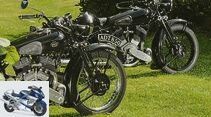
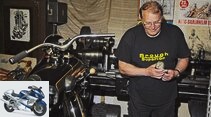
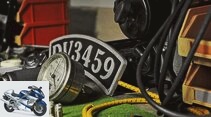
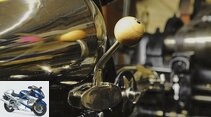
11 pictures
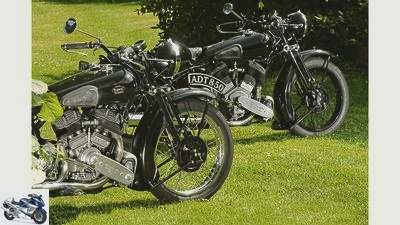
Fred Siemer
1/11
In front the SS 80 with Matchless-V2, in the back the 11.50 with the JAP. And soon they’ll get chrome-plated tanks too.
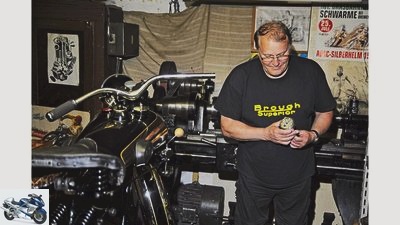
Fred Siemer
2/11
Kurt recently restored a “small” brough with a 680 ohv JAP. Now he only dreams of an SS 100.
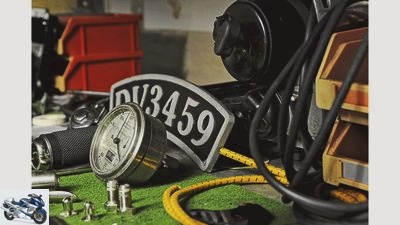
Fred Siemer
3/11
Each brough superior was finely composed. And that’s why small parts play an important role.
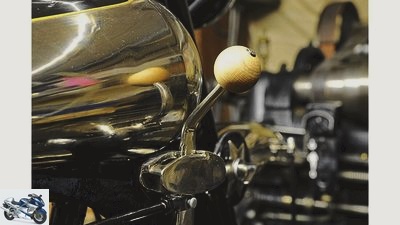
Fred Siemer
4/11
Trademark: The chrome-plated tank sides reflect the rest of the world.
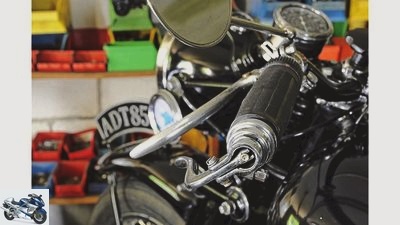
Fred Siemer
5/11
George Brough appreciated a clean appearance – and banished all cables to the handlebars.
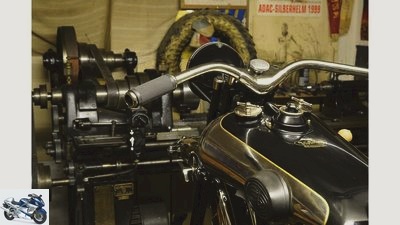
Fred Siemer
6/11
Those who keep their brough running reliably enjoy the respect of club friends.
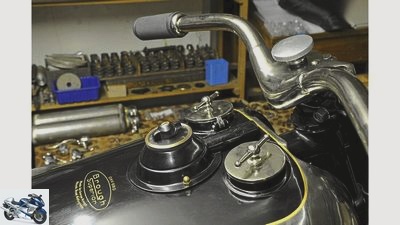
Fred Siemer
7/11
Portrait brough specialist Kurt.
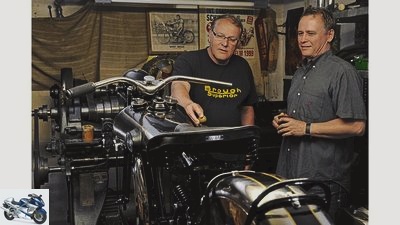
Fred Siemer
8/11
Kurt and his friend discuss the 680 restoration. Take it easy, because otherwise it won’t work.
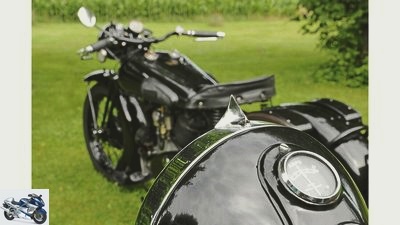
Fred Siemer
9/11
The attention to detail knew no bounds, as this wonderfully pointless target arrangement aptly proves.
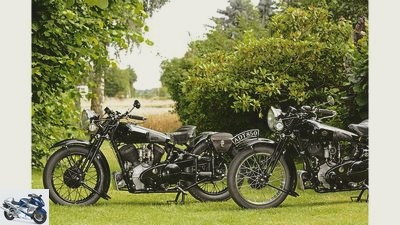
Fred Siemer
10/11
Brough Superior 11.50 and Brough Superior SS 80 De Luxe.
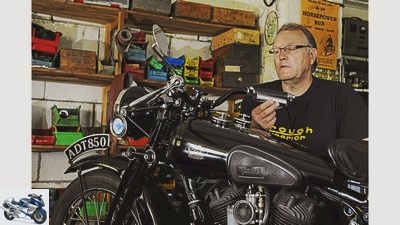
Fred Siemer
11/11
Portrait of the brough specialist Kurt.
Sports & scene
Portrait of the brough specialist Kurt Harries
Portrait of the brough specialist Kurt Harries
At the same height
Content of
A Brough Superior will always be something very special. But Kurt Harries too: he can restore them.
Fred Siemer
10/06/2016
To place yourself at the top, you have to want that. George Brough wanted. The son of a motorcycle manufacturer differentiated his products from those of his father with the nickname Superior, was already running extremely class-conscious advertising at the start of sales in 1920 and measured himself and his craftsmen to the highest standards every day. With success: In 1924 a British motorcycle journalist ennobled the freshly tested SS 80 with the title “Rolls-Royce of motorcycles”, which has been in use since then. Sports triumphs and record drives increased the fame, which finally rose into the mythical, when T. E. Lawrence, the English writer and colonel also known as Lawrence of Arabia, in 1935 on a Brough Superior had a fatal accident. His SS 100 with head-controlled JAP-V2 was one of 281 that were made between 1924 and 1935. By 1940 another 102 with Matchless engines were added.
Buy complete article
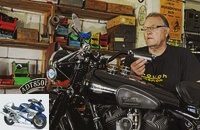
Portrait of the brough specialist Kurt Harries
At the same height
6 pages) as PDF
€ 2.00
Buy now
In contrast, the side-controlled and less powerful SS 80s appear almost folksy, as almost 1,100 of them have rolled out of the small factory in Nottingham’s Haydn Street over the years. 460 of them with Matchless V-Twin. Kurt Harries has one of those. For 17 years. Has he reached the top now? “Nonsense,” grins the cheerful retiree, “but I know what you mean.” Exactly: the astonishing record reports about auction prices of all possible broughs, most recently those pitiful finds from Bodmin Moor in Cornwall. Even core scrap still makes astronomical sums of money, and several Broughs are always among the top ten most expensive motorcycles. The inexperienced observer naturally asks himself whether he gradually loses his grip on the ground when dealing with such a part.
“Kurt, now pick that thing up.”
Kurt invalidates this assumption with stunning friendliness and rural charm, and the dress code around his workshop also reveals that he is more like Uwe Seeler: normal is the most beautiful. On the one hand. On the other hand, it borders on the abnormal, what the trained electrician has already restored everything in his life. Kurt can’t be frightened, he turns a heap of misery into a functional eye-catcher, and after he had tested his skills on a rare 350 standard off-road sport from 1935 or a Royal Ruby team from 1916, which was once intended for the Russian Tsar’s court, woke us up rusted brough torso his interest. He was slumbering in the barn of a friend who was a dealer. And slumbered … and slumbered … Finally the dealer wanted to build a house and picked up the phone. “Kurt, now pick that thing up.”
The torso wasn’t free, of course, but the message was clear. “You don’t get such a chance very often,” recalls Kurt, “the bike was almost complete.” Two roadworthy Ardies and a Borgward Isabella Coupe had to believe in it until the financing was in place. The seat, fenders, fittings and handlebars were wrong, the tank had lost all of its chrome, and some small parts were missing. But the candles still looked good. And they radioed. So plugged in a makeshift tank and on it. Kurt was flabbergasted: “The engine came on the first step. Really. ”Nevertheless, after such a long downtime, the engine naturally turned out to be a maintenance requirement and was rebuilt down to the last screw. Problems? “The auger for the oil pump drive was broken, and installing it is a little fiddly.” Aha. After six months, the SS 80 was far from being in its original condition, but it was running.
Only the finest
Kurt and his wife have actually been spending their holidays at their beloved veteran rallies for ages. With the noble British twin, their range expanded again considerably, because the Brough Superior Club has been promoting the use of these motorcycles since 1958. That’s what the club’s rules say, and Kurt thought that was great. Especially since these gentlemen are not kidding and really demanding their veterans. At the same time, they promote the survival of the rare machines – this is also required by the association’s rules. Just as George Brough personally maintained the supply of spare parts after the war, so do the members for one another today. Those who are registered get parts and can browse through lists beforehand, which should move friends of other pre-war veterans to tears. Kurt found out about this when he headed for his first Brough meeting in Hengelo, Holland, in 2001, and immediately joined the noble club. He bought luggage bags, handlebars and fittings through the club. “But of course they don’t have everything either.” This strange aiming device on the headlight, for example. “That should come from aviation, from the hunters. Well, it doesn’t matter, but until I found the right material … “But it had to be, because a Brough Superior likes to adorn itself with such a thing.
Typical of George Brough, the equipment specialist. The man was not an outstanding technician, but as a driver he was one of the great English pioneers and knew what counts on the country road or what makes you fast on record drives. He had won the long-distance trip from London to Edinburgh on his father’s motorcycles three times in a row from 1910 onwards, and in 1922 he was the first to bring a side valve to over 100 miles per hour. A tuned SS 80. He certified every single serial counterpart, if requested and at an additional cost, by means of a certificate that they had walked 80 miles (or 100 for the ohv-SS). Strong stuff at the time and far removed from most of what was going around. Brough’s genius was to configure his motorcycles to be fast on the country roads of the time. And persistent. That is why he consistently only bought the very best. Enfield brakes, Harley forks, Smiths watches, Burman gears, and so on. Everywhere he asserted his high quality standards, and those who did not meet them were punished. He even messed with JAP when their ohv-V2, the JTOS engine, introduced in 1934, was annoying with teething problems. Without further ado, Brough switched to Matchless for his two SS models.
308 touring machines were built by 1940
The heaviest brough, however, kept its specially developed 60-degree JAP-V2. This touring machine named 11.50, introduced in 1933, was intended to be used in the strenuous traffic of authorities and sidecars, a total of 308 were built by 1940. One of them ended up in Hamburg two years ago, to a friend of Kurt’s. He wanted to have it restored, but that didn’t make any progress. Until Kurt had some understanding and the whole project ended up in his workshop basement. JAP engine, why not? “We used to be in rail sports.” At the beginning of the 70s, wild times back then and in all of north-west Germany still the great era of long-distance railways. Kurt was there, no: right in the middle, because once he even became a master at JuPo. A few years later, a serious accident ended his driving career, but he continued as club chairman. Firmly in loyalty, almost three decades.
Last summer he took the club’s Eifel trip with Thomas, the friend. It was really jagged, over 1000 kilometers long. Kurt was once again pleased that he had given his twin new pistons three years ago: “Now it pulls much more energetically.” And that – a long time ago – he was able to get hold of an original magneto at a parts market. “Before that, it often got too hot for me.” Always around to the left in a circle, dust and noise and drift and danger – JAP motors were also made for that. Now just as V2 in a luxurious guise. The restoration went smoothly, although some of the frame had to be reinforced and welded. Two fork legs now house reinforcing tubes, Kurt is really impressed by the 11.50’s even higher ride comfort compared to the SS 80: “The engine comes out super smoothly from below, yes, and then the rear already has straight-way suspension.”
Cleaning boy
The English club colleagues quickly noticed how well and persistently this motorcycle runs. That earned respect. The British only laugh when Kurt explains that the technical condition corresponds to the optical condition. “They always call me cleaning boy and smile. You mostly discover while cleaning what is loose and so, right? “
Experience shows that Kurt is right. Only recently when he noticed that the sleeve of the throttle grip had broken. Too bad it doesn’t appear on any of the club’s parts lists. Then he measured it. “I could have done it right away.” The thing has the same dimensions as a standard sink drain pipe. You just have to know how to help yourself. Also in dealing with the two-wheeled high nobility.
Technical data Brough Superior 11.50
Brough Superior 11.50
Engine: JAP 60-degree V-two-cylinder four-stroke engine, bore x stroke 85.5 x 95 mm, displacement 1096 cm³, two standing valves per combustion chamber, operated by a gear-driven camshaft and bumpers below, an Amal carburetor with double Float chamber, dry sump lubrication, approx. 35 HP at 4200 rpm
Drive: Primary drive via chain, Norton multi-plate dry clutch, Norton four-speed gearbox with foot shift, secondary drive via chain
Landing gear: Closed monotube frame with forked beam, Monarch fork at the front with pushed short swing arm with friction damper, rear straight travel suspension (in the range since 1937), tires front and rear 3.50 x 19 and 4.00 x 19, Enfield 7-inch Simplex half-hub brakes front and rear, Wheelbase 1500 mm, dry weight approx. 220 kg. A total of 82 of the 11.50 were built in this form from 1937 to 1940.
Technical data Brough Superior SS 80 De Luxe
Brough Superior SS 80 De Luxe
Engine: Matchless 50-degree V-two-cylinder four-stroke engine, bore x stroke 85.7 x 85.5, displacement 990 cm³, two standing valves per combustion chamber, operated by a gear-driven camshaft and bumpers below, an Amal carburetor, Dry sump lubrication, approx. 30 HP at 4300 rpm
Drive: Primary drive via chain, Norton multi-plate dry clutch, Norton four-speed gearbox with foot shift, secondary drive via chain
Landing gear: Closed monotube frame with forked beam and rigid rear (straight-way suspension available from 1937 at an extra charge), Monarch fork in front with pushed short swing arm with friction damper, front and rear tires 3.50 x 19 and 4.00 x 19, Enfield 7-inch simplex half-hub brakes in front and rear, wheelbase 1500 mm, dry weight approx. 210 kg. A total of 64 SS 80s were built in this form from 1938 to 1940.
Related articles
-
Scrambler Motorcycles in portrait
Michael Orth Sports & scene Scrambler Motorcycles in portrait Scrambler Motorcycles in portrait “Just a hobby” Content of Daniel, Migge and Sven convert…
-
Driving report Brough Superior S.P. 100
Kyoichi Nakamura motorcycles Driving report Brough Superior S.P. 100 Driving report Brough Superior S.P. 100 Rebirth A legend has resurrected: the famous…
-
Portrait of US collector Fred Mork
Blacksmith 27 pictures Blacksmith 1/27 The similarity between human and … Blacksmith 2/27 Blacksmith 3/27 Tons of story (s): whether model kits,…
-
Scene – workshop portrait Zweirad Wiebusch
Thomas Schmieder 10 pictures Thomas Schmieder 1/10 Picture gallery: Workshop portrait Zweirad Wiebusch. Thomas Schmieder 2/10 Marco Wiebusch is all about…
-
Portrait: two-wheeler dealer Fritz Roth
Winni washer Sports & scene Portrait: two-wheeler dealer Fritz Roth scene Portrait of Fritz Roth Content of Fritz Roth has dedicated himself to the…
-
The Marathon Harley: “The Motorcycle” – Brief portrait of Peter and Kay Forwood
Forwood to travel The Marathon Harley: &# 34; The Motorcycle&# 34; – Brief portrait of Peter and Kay Forwood The Marathon Harley “The motorcycle” – Brief…
-
Fred Siemer 16 pictures Fred Siemer 1/16 Norbert Schuller knows the sensitive Konig four-cylinder like no other. Fred Siemer 2/16 Every handle has been…
-
2snap 6th pictures Friedemann Kirn 1/6 Toni Bou has already won 20 world titles in the trial. Friedemann Kirn 2/6 Superstar without special requests -…
-
Wunderlich RockBob: accessory specialist is converting
Wunderlich GmbH 8th pictures Wunderlich GmbH 1/8 Wunderlich has converted a BMW R18 Classic into a bobber. Wunderlich GmbH 2/8 Style-defining is the rear…
-
Scene: Portrait of two-stroke fan Scherubl
Siemer 15th pictures Siemer 1/15 The two-stroke fan Gunter Scheruebl transforms old series motorcycles into racing replicas. Siemer 2/15 Scherubl can…